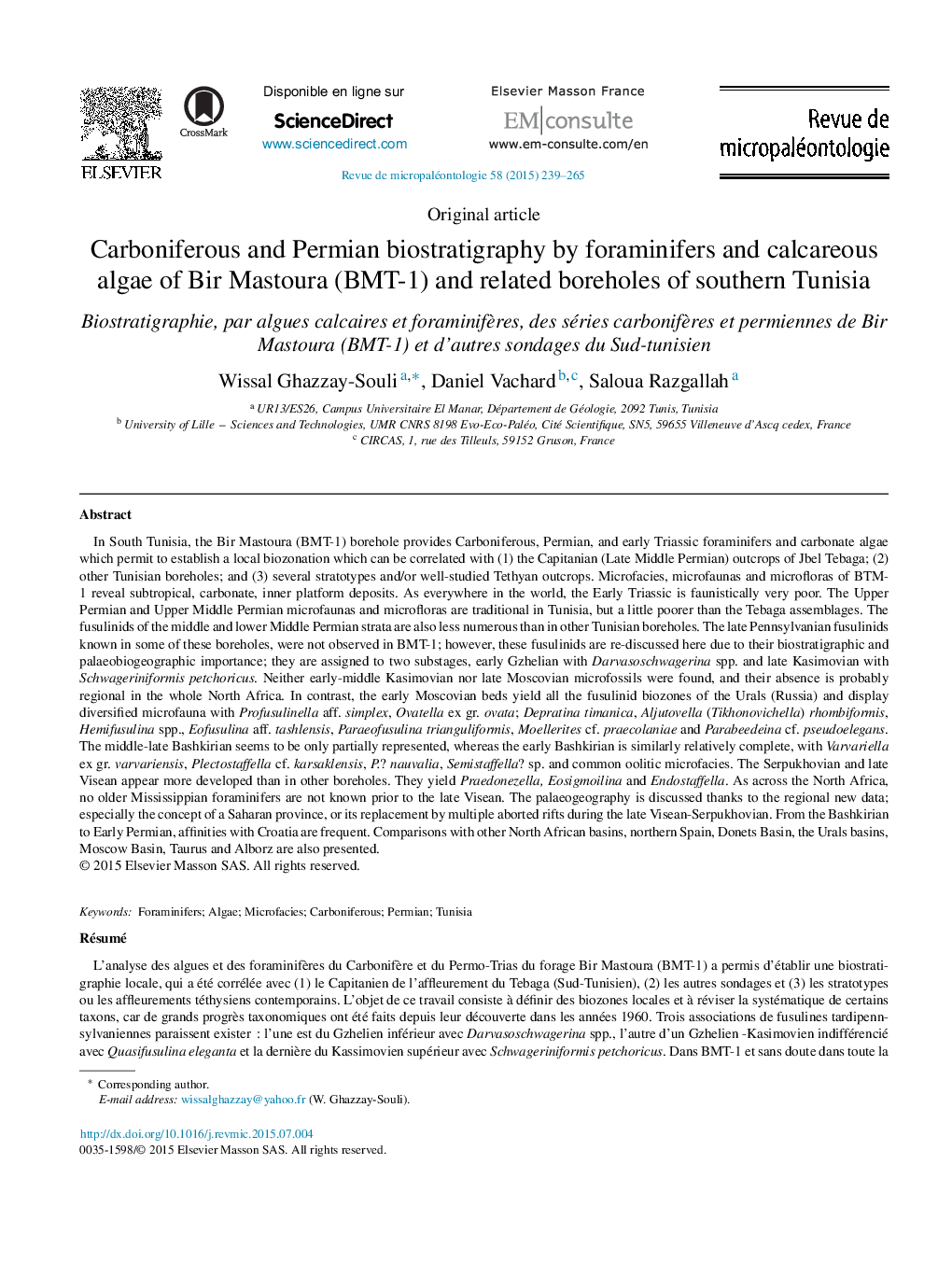| کد مقاله | کد نشریه | سال انتشار | مقاله انگلیسی | نسخه تمام متن |
|---|---|---|---|---|
| 4751395 | 1361053 | 2015 | 27 صفحه PDF | دانلود رایگان |

In South Tunisia, the Bir Mastoura (BMT-1) borehole provides Carboniferous, Permian, and early Triassic foraminifers and carbonate algae which permit to establish a local biozonation which can be correlated with (1) the Capitanian (Late Middle Permian) outcrops of Jbel Tebaga; (2) other Tunisian boreholes; and (3) several stratotypes and/or well-studied Tethyan outcrops. Microfacies, microfaunas and microfloras of BTM-1 reveal subtropical, carbonate, inner platform deposits. As everywhere in the world, the Early Triassic is faunistically very poor. The Upper Permian and Upper Middle Permian microfaunas and microfloras are traditional in Tunisia, but a little poorer than the Tebaga assemblages. The fusulinids of the middle and lower Middle Permian strata are also less numerous than in other Tunisian boreholes. The late Pennsylvanian fusulinids known in some of these boreholes, were not observed in BMT-1; however, these fusulinids are re-discussed here due to their biostratigraphic and palaeobiogeographic importance; they are assigned to two substages, early Gzhelian with Darvasoschwagerina spp. and late Kasimovian with Schwageriniformis petchoricus. Neither early-middle Kasimovian nor late Moscovian microfossils were found, and their absence is probably regional in the whole North Africa. In contrast, the early Moscovian beds yield all the fusulinid biozones of the Urals (Russia) and display diversified microfauna with Profusulinella aff. simplex, Ovatella ex gr. ovata; Depratina timanica, Aljutovella (Tikhonovichella) rhombiformis, Hemifusulina spp., Eofusulina aff. tashlensis, Paraeofusulina trianguliformis, Moellerites cf. praecolaniae and Parabeedeina cf. pseudoelegans. The middle-late Bashkirian seems to be only partially represented, whereas the early Bashkirian is similarly relatively complete, with Varvariella ex gr. varvariensis, Plectostaffella cf. karsaklensis, P.? nauvalia, Semistaffella? sp. and common oolitic microfacies. The Serpukhovian and late Visean appear more developed than in other boreholes. They yield Praedonezella, Eosigmoilina and Endostaffella. As across the North Africa, no older Mississippian foraminifers are not known prior to the late Visean. The palaeogeography is discussed thanks to the regional new data; especially the concept of a Saharan province, or its replacement by multiple aborted rifts during the late Visean-Serpukhovian. From the Bashkirian to Early Permian, affinities with Croatia are frequent. Comparisons with other North African basins, northern Spain, Donets Basin, the Urals basins, Moscow Basin, Taurus and Alborz are also presented.
RésuméL’analyse des algues et des foraminifères du Carbonifère et du Permo-Trias du forage Bir Mastoura (BMT-1) a permis d’établir une biostratigraphie locale, qui a été corrélée avec (1) le Capitanien de l’affleurement du Tebaga (Sud-Tunisien), (2) les autres sondages et (3) les stratotypes ou les affleurements téthysiens contemporains. L’objet de ce travail consiste à définir des biozones locales et à réviser la systématique de certains taxons, car de grands progrès taxonomiques ont été faits depuis leur découverte dans les années 1960. Trois associations de fusulines tardipennsylvaniennes paraissent exister : l’une est du Gzhelien inférieur avec Darvasoschwagerina spp., l’autre d’un Gzhelien -Kasimovien indifférencié avec Quasifusulina eleganta et la dernière du Kassimovien supérieur avec Schwageriniformis petchoricus. Dans BMT-1 et sans doute dans toute la région, et cela à l’inverse de ce que soutenait la littérature, le Moscovien supérieur fait défaut. Par contre, le Moscovien inférieur est bien représenté avec ses habituels grainstones à beresellales et ses fusulines marqueuses de zone : Profusulinella aff. simplex, Ovatella ex gr. ovata ; Depratina timanica, Aljutovella (Tikhonovichella) rhombiformis, Hemifusulina spp., Eofusulina aff. tashlensis, Paraeofusulina trianguliformis, Moellerites cf. praecolaniae et Parabeedeina cf. pseudoelegans. Le Bachkirien supérieur paraît manquer, alors que les niveaux inférieurs de cet étage, Bogdanovien et Syuranskien, semblent continûment enregistrés avec des niveaux à Varvariella ex gr. varvariensis, Plectostaffella cf. karsaklensis, P.? nauvalia, Semistaffella? sp. et de nombreux microfaciès oolithiques. Le Serpoukhovien est probablement aussi peu complet et n’est guère caractérisé que par Praedonezella et Eosigmoilina. Cependant, Serpukhovien et Viséen supérieur sont mieux caractérisés dans BMT-1 que dans les autres sondages, où les microfaunes représentées, n’étaient pas antérieures au Bachkirien inférieur. Cependant, et comme dans tout le Maghreb, aucune microfaune de foraminifères n’est plus ancienne que le Brigantien (MFZ15) ou peut-être l’Asbien (MFZ14). La paléogéographie fait l’objet d’une nouvelle discussion fondée sur les résultats biostratigraphiques et taxonomiques. Nous discutons surtout la notion de province Saharienne, qu’on pourrait remplacer par de multiples rifts ouverts au Viséen supérieur-Serpoukhovien. Du Bachkirien au Permien inférieur, de nombreuses affinités de peuplement avec la Croatie sont constatées. Des comparaisons sont également tentées avec les autres grands bassins d’Afrique du Nord, ceux des Cordillères cantabriques dans le Nord de l’Espagne, le Bassin du Donetz, le Bassin de Moscou et ceux de l’Oural, enfin ceux du Proche- et du Moyen-Orient.
Journal: Revue de Micropaléontologie - Volume 58, Issue 3, July–September 2015, Pages 239–265